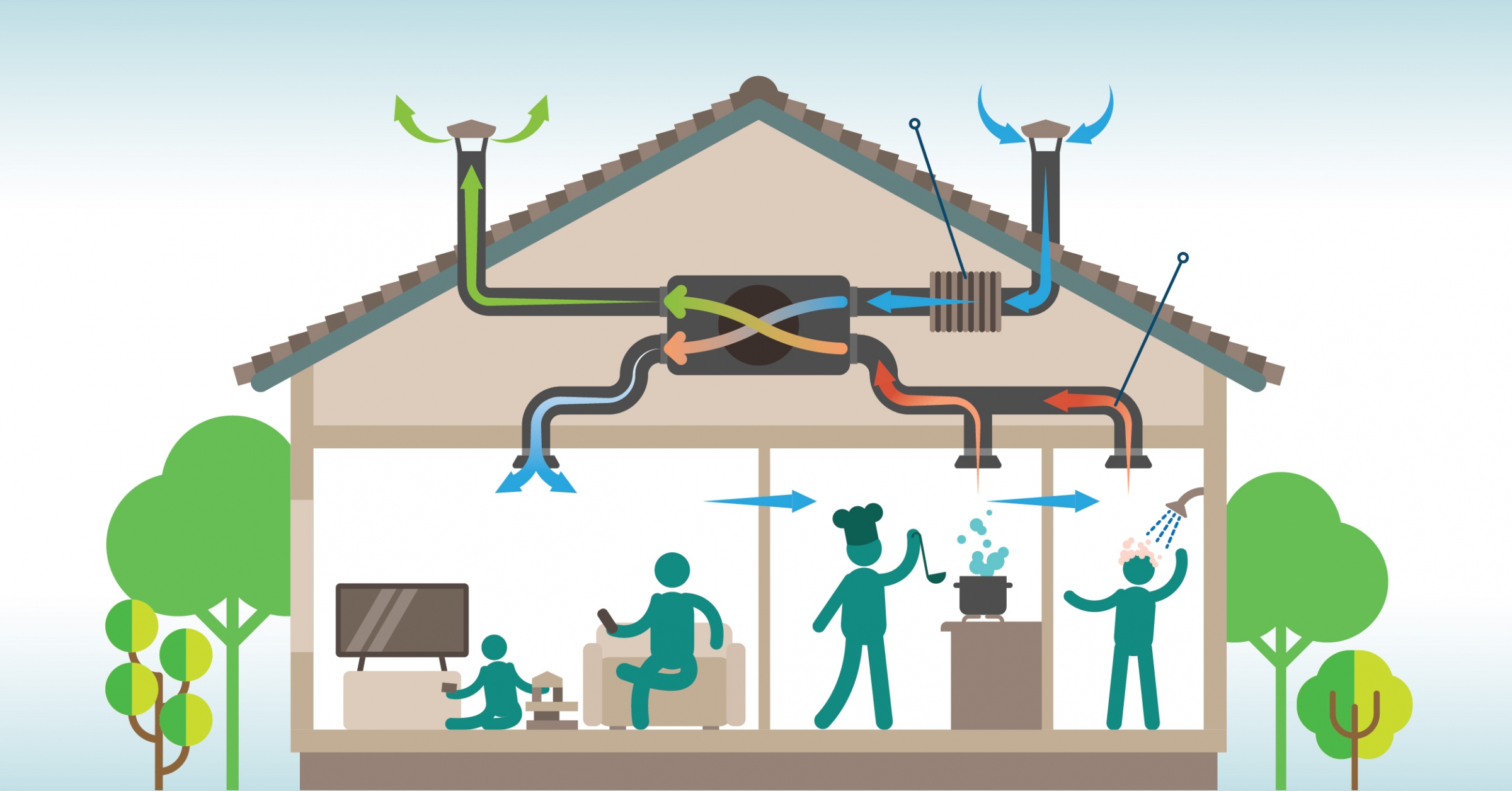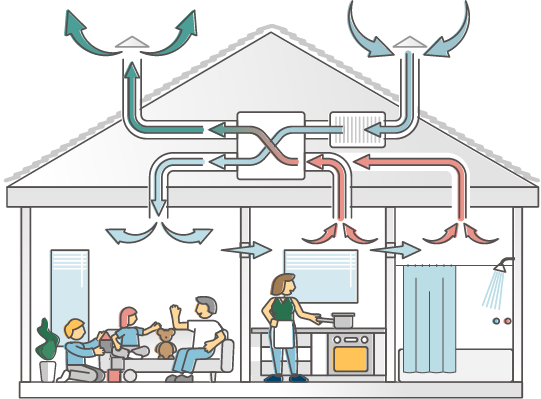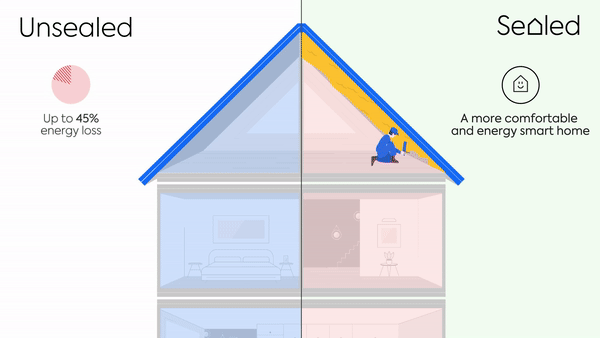Why Families in Sydney Trust Home Ventilation Melbourne Services
Wiki Article
Understanding the Importance of Home Air Flow for a Healthier Living Setting
Home ventilation plays an essential duty in preserving a healthy living atmosphere. It facilitates the exchange of exterior and indoor air, which is vital for enhancing air high quality. Without proper air flow, homes can end up being reproducing premises for contaminants and irritants. The repercussions of insufficient air blood circulation can be substantial. This raises the inquiry of exactly how home owners can properly carry out air flow approaches to safeguard their health and wellness and health. Recognizing these approaches is vital.
The Basics of Home Air Flow
Home air flow serves as an important component of indoor air quality and convenience. It entails the process of exchanging stagnant interior air with fresh outside air, consequently decreasing humidity and regulating temperature. Appropriate air flow systems can consist of natural methods, such as open home windows and vents, in addition to mechanical systems, such as exhaust fans and air exchangers. Reliable home ventilation aids prevent issues like interior mold and mildew development and the buildup of harmful fragments. It additionally enhances overall power performance, as well-ventilated areas can preserve comfortable temperature levels with much less dependence on home heating and cooling down systems. Comprehending the fundamentals of home air flow is vital for homeowners looking for to create a much healthier living atmosphere for themselves and their families.
Common Resources of Indoor Air Air Pollution

Although many may not realize it, indoor air contamination can stem from various sources within a family. Typical factors consist of unpredictable organic substances (VOCs) given off from paints, solvents, and cleaning items. Household appliances, such as gas stoves and fireplaces, can launch harmful gases like carbon monoxide gas and nitrogen dioxide. In addition, mold and mildew prosper in wet areas, releasing spores that impact air top quality. Family pet dander, dust termites, and plant pollen can accumulate inside, additional worsening contamination levels. Cigarette smoking inside creates harmful chemicals that linger in the air. Constructing materials, including asbestos and formaldehyde, can off-gas hazardous compounds. Acknowledging these sources is essential for maintaining a much healthier interior environment and advertising effective ventilation strategies.
Health And Wellness Consequences of Poor Ventilation
Interior air pollution can have significant health implications, specifically when air flow is inadequate. Poor air flow can bring about the build-up of harmful toxins, such as unpredictable natural compounds, mold, and particulate issue. This accumulation may cause respiratory system issues, consisting of asthma, allergies, and persistent obstructive lung illness. Individuals might experience symptoms like migraines, tiredness, and inflammation of the eyes, nose, and throat. Prone populaces, such as youngsters and the senior, go to higher risk for severe wellness results. Long-lasting direct exposure to inadequately ventilated environments can also add to much more significant conditions, consisting of cardiovascular conditions. Subsequently, ensuring correct ventilation is crucial for keeping a healthy and balanced living atmosphere and minimizing the danger of health and wellness issues connected with indoor air contamination.Effective Air Flow Techniques for Your Home
Proper ventilation is essential for keeping a healthy and balanced interior environment, and carrying out effective methods can greatly enhance air quality. House owners can start by making sure that exhaust followers are mounted in kitchen areas and bathrooms to eliminate excess moisture and smells. Opening home windows routinely permits fresh air to circulate, particularly throughout mild weather condition. In addition, making use of air purifiers with HEPA filters can assist record airborne pollutants. For homes with home heating and cooling down systems, maintaining HVAC systems and altering filters on a regular basis is crucial for peak performance. Including all-natural air flow strategies, such as cross-ventilation, can also improve air flow. Ultimately, securing any leaks in doors and windows avoids undesirable drafts, which can disrupt controlled air movement, inevitably leading to improved interior air top quality and convenience.Keeping Optimum Air Top Quality Year-Round
To preserve suitable air top quality year-round, homeowners must adopt a proactive approach to handling their interior setting. Consistently monitoring interior air top quality is essential; this includes checking for toxins such as dirt, mold, and volatile organic substances (VOCs) Applying efficient ventilation systems, such as exhaust followers and air purifiers, can significantly minimize air-borne contaminants. Additionally, routine maintenance of a/c systems warranties peak efficiency and air circulation. Homeowners must likewise consider moisture levels, as too much dampness can cause mold and mildew development. Seasonal changes might require changes in ventilation methods to fit differing outside air quality. By focusing on these practices, property owners can develop a healthier home, promoting total well-being for all occupants throughout the year.Regularly Asked Questions
Exactly How Can I Tell if My Home Needs Better Ventilation?
To determine if a home requires much better air flow, one need to observe indications such as relentless humidity, mold development, musty odors, condensation on home windows, or raised allergic reaction signs and symptoms, indicating poor air movement and potentially inadequate indoor air high quality.What Are the Indicators of Poor Indoor Air Quality?

Can Houseplants Improve Indoor Air High Quality Effectively?
The effectiveness of houseplants in improving indoor air high quality is debated. While some research studies recommend they can absorb toxic substances and generate oxygen, their overall effect might be minimal contrasted to proper ventilation and air filtering systems.Just how Frequently Should I Adjustment My Air Filters?
The frequency of air filter modifications commonly depends on usage and filter type. Usually, it is recommended to replace filters every 3 months, though families with allergic reactions or pets Home Ventilation Melbourne may require more regular adjustments for suitable efficiency.Exist Any Kind Of Specific Ventilation Systems for Allergic Reaction Sufferers?
Several air flow systems, such as HEPA-filtered devices, effectively reduce allergens airborne. Home Ventilation Melbourne. These systems catch dirt, pollen, and animal dander, giving allergy victims with a cleaner, healthier interior atmosphere while taking care of air high quality effectively
It helps with the exchange of interior and exterior air, which is important for boosting air high quality. Home ventilation serves as an important component of interior air high quality and comfort. It includes the process of trading stale indoor air with fresh outdoor air, thereby lowering humidity and controlling temperature. Indoor air pollution can have significant wellness ramifications, particularly when ventilation is insufficient. Appropriate ventilation is important for maintaining a healthy and balanced indoor environment, and carrying out efficient strategies can substantially improve air quality.
Report this wiki page